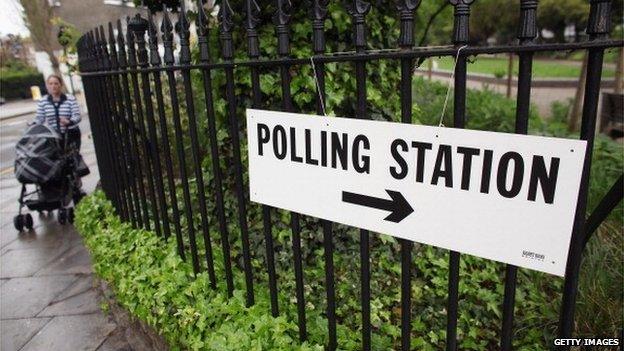The huge choice for voters
- Published
- comments

The economic choice confronting voters is the starkest since 1992. That is the assessment of the Institute for Fiscal Studies of the main parties' deficit reduction plans.
The best way of seeing this choice is that, if the Tories and Labour deliver their plans, the national debt by 2020 would be £90bn lower in today's money under the Conservatives, but cuts to so-called unprotected government departments would be just £1bn under Labour compared with £30bn under the Tories.
Or to put it another way, voters have a choice between considerably less austerity under Labour and considerably more debt reduction under the Tories.
Which route is better?
I put this to Paul Johnson, the director of the IFS. But he's keen not to sacrifice the IFS's precious reputation for political neutrality. So he did that politician's thing of dodging the answer.
But here is a way of making your own mind up.
The national debt has doubled to 80% of GDP or national income since the great crash of 2008. Under Tory plans it would be cut to 72% of GDP by 2020, but to just 77% of GDP under Labour.
If you think there is a big likelihood of another major economic shock in the next few years, you would favour getting the national debt down faster - because there would be a bit more room for debt to rise in the next recession without turning the UK, in public finance terms, into Italy or Greece.
Wealth warning
But in order to get the national debt down at that speed, cuts to defence, transport, law and order and social care would have to be very deep indeed.
The Tories' fiscal ambitions would see the scale and pace of cuts in these services very similar to what has happened in the current parliament - or around 18% over four years.
Now the IFS argues that achieving those cuts in the coming four years may well be harder than in the parliament just ending, without undermining the quality of those services, for two reasons:
first, that the simpler efficiency improvements have presumably been made already;
second, it will be harder to maintain negligible public-sector pay rises, especially if we see the desired recovery in private sector wage growth.
So, to repeat, the choice is between a more robust public-sector balance sheet under the Tories, and public-sector services more like we have today under Labour.
That said, the IFS has made an important wealth warning, which is that there are big lacunae in both Tory and Labour plans.
In the case of the Tories, we simply don't know how the Tories would make their big departmental cuts, or how they would save their promised £10bn from the welfare bill, or how they would fund £8bn of promised spending on the NHS, or finance £4bn of pledged net tax cuts.
Or to put it another way, they may not - in practice - achieve their relatively faster reduction in the ratio of debt to GDP.
As for Labour, the IFS is frustrated by its failure to put a more precise date on when it will hit its target of balancing the budget, excluding investment, and whether it actually wants a surplus rather than just a nil balance.
But it also concedes that keeping voters to an extent in the dark is nothing new (oh yes) and that we actually have more detail on their respective plans than we had five years ago.
PS The IFS says of the SNP that its overall fiscal plans are consistent with Labour's.
But it says there is a gap between SNP rhetoric on its determination to end austerity and the implications of its fiscal plans - since it says the SNP would have gentler austerity in the next parliament than the other parties, but longer austerity.
Meanwhile the IFS loves the LibDems for giving more fiscal detail than the other parties, & says it would be less austere than the Tories but more austere than Labour.
That said, it bemoans the £10bn the LibDems plan to raise from cracking down on tax avoidance and tax evasion - far more than the other parties' - because of the absence of how it would actually do this.